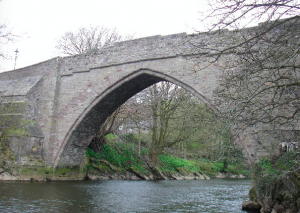One of the principal purposes of this blog is to give anyone who is contemplating a move to Aberdeen lots of varied and interesting information about life and leisure in the North-East of Scotland. To that end, we’re fortunate in that there is so much to see and do in the city and surrounding areas. One of our recent blogs looked at some of the more common blunders made in local websites and included a reference to the ‘Brig o’Balgownie’ and promised a future blog on that subject. And, as our headline suggests, there is far more to it than a mere collection of bricks and stone to cross a river!
The Brig o’Balgownie is a bridge across the river Don. It’s also one of the oldest bridges in Scotland. It may seem hard to believe when you look at it today, but when it was first built it was one of the biggest bridges in the country and was the only means of accessing Aberdeen by road from the north.
As far as we can tell, work on the bridge was started by the first recorded Provost of Aberdeen, a man called Richard Cementarius, who as well as being Provost was also a mason. He was Provost (Alderman) between 1272-3 and it’s believed that work on the bridge started during this time. However, the person who actually commissioned the bridge is reckoned to be either Henry Cheyne, Bishop of Aberdeen between 1285 and 1328, or Robert the Bruce (1274-1329). The latter, as every Scottish schoolchild knows, was the successful leader of Scotland’s war of independence who, after defeating the English army at Bannockburn, became Robert I of Scotland. Most accounts suggest that Bishop Cheyne initially commissioned the bridge but, as he was on the opposing side to Robert the Bruce, he had to flee the country during the war of independence.
Construction of the bridge made sense to a king like Robert, enabling him and his successors to move armies relatively quickly along the north-east side of Scotland and also providing a conduit for trade (without which there was no money to pay for the army!). The bridge was used extensively for several hundred years, but fell into disrepair in the sixteenth century at the time of the Reformation. It was then extensively rebuild by the Town Council in 1605. Subsequent repairs have kept the bridge going up until the present and are of professional interest to engineers, as can be seen from this article sponsored by the Institute of Civil Engineers.
The Brig o’Balgownie remained important until the nineteenth century, when the present day Bridge of Don was completed in 1830. Since then it has obviously declined in importance but it is still open today and in use by pedestrians and cyclists.
The name ‘Balgownie’ is Gaelic in origin and refers to the area around the bridge, which was originally a barony. It is thought that the first part of the name comes from the word ‘Baile’, meaning ‘town’. The second part either comes from the word ‘gabhainn’, meaning a cattle-pen, or from the word gobhainn, which means either a ‘smith’ or possibly a ‘blacksmith’.
Lord Byron (1788-1824), who famously grew up in Aberdeen and attended Aberdeen Grammar School, must have been well aware of the Brig, as he refers to it in his famous poem, Don Juan,
“As ‘Auld Lang Syne’ brings Scotland, one and all,
Scotch plaids, Scotch snoods, the blue hills, and clear streams,
The Dee, the Don, Balgounie’s brig’s black wall,
All my boy feelings, all my gentler dreams
Of what I then dreamt, clothed in their own pall,
Like Banquo’s offspring; – floating past me seems
My childhood in this childishness of mine:
I care not – ’tis a glimpse of ‘Auld Lang Syne.’”
So there you have it – one of the oldest bridges in the country, Scotland’s most famous king and a celebrated, raffish poet – if that’s not enough to make you consider a move to Aberdeen I don’t know what is! And if you live locally and haven’t seen the Brig recently it’s worth taking the time to do so. A plaque was placed on it in 1981, describing its history and recording its importance to the city. The bridge is a Scheduled Ancient Monument (since 1923) and has Category A listed building status.
Julie Skinner, Resourcing & Benefit Specialist
Email: j.skinner@rgu.ac.uk


